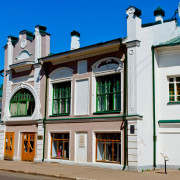Федеративная республика бразилия и ее достопримечательности
Содержание:
Administrative divisions
Politically, Brazil is a federation of twenty-six states and one federal district.
The national territory was divided in 1969, into five main regions: North, Northeast, Central-West, Southeast, and South.
The North covers 45.27 percent of the surface of Brazil and has the lowest number of inhabitants. With the exception of Manaus, which hosts a tax-free industrial zone, and Belém, the biggest metropolitan area of the region, it is fairly unindustrialized and undeveloped. It accommodates most of the rainforest vegetation of the world and many indigenous tribes.
The Northeast, inhabited by about 30 percent of Brazil’s population, is culturally diverse, with roots set in the Portuguese colonial period and in Amerindian and Afro-Brazilian elements. It is also the poorest region of Brazil and suffers from long periods of dry climate. The largest cities are Salvador, Recife, and Fortaleza.
The Central-West region has low demographic density when compared to the other regions, mostly because part of its territory is covered by the world’s largest marshlands area, the Pantanal, as well as a small part of the Amazon rainforest in the northwest. Much of the region is covered by Cerrado, the largest savanna in the world. The Central-West region contributes significantly toward agriculture. The largest cities of this region are: Brasília (the capital), Goiânia, Campo Grande, Cuiabá, Anápolis, Dourados, Rondonópolis, and Corumbá.
The Southeast region is the richest and most densely populated. It has more inhabitants than any other South American country and hosts one of the largest megalopolises of the world. The main cities are the country’s two largest: São Paulo and Rio de Janeiro. The region is very diverse, including the major business center of São Paulo, the historical cities of Minas Gerais and its capital Belo Horizonte, the beaches of Rio de Janeiro, and the coast of Espírito Santo.
The South is the wealthiest by GDP per capita and has the highest standard of living in the country. It is also the coldest region of Brazil, with occasional occurrences of frost and snow in some of the higher altitude areas. It has been settled by European immigrants, mainly of Italian, German, Portuguese, and Slavic ancestry, and has clearly been influenced by these cultures. The largest cities in this region are Curitiba, Porto Alegre, Florianópolis, Londrina, Caxias do Sul, and Joinville.
Credits
New World Encyclopedia writers and editors rewrote and completed the Wikipedia article
in accordance with New World Encyclopedia standards. This article abides by terms of the Creative Commons CC-by-sa 3.0 License (CC-by-sa), which may be used and disseminated with proper attribution. Credit is due under the terms of this license that can reference both the New World Encyclopedia contributors and the selfless volunteer contributors of the Wikimedia Foundation. To cite this article click here for a list of acceptable citing formats.The history of earlier contributions by wikipedians is accessible to researchers here:
Brasilia, Brazil history
The history of this article since it was imported to New World Encyclopedia:
History of «Brasilia, Brazil»
Note: Some restrictions may apply to use of individual images which are separately licensed.
Culture
Brazilian Carnival parade in Rio de Janeiro.
A wide variety of elements influenced Brazilian culture. Its major early influence derived from Portuguese culture. Among other inheritances, the Portuguese introduced the Portuguese language, the Roman-Germanic legal system, and colonial architectural styles. Other aspects of Brazilian culture are contributions of European and Asian immigrants, native South American people (such as the Tupi), and African slaves. Thus, Brazil is a multicultural and multiethnic society. Italian, German, and other European immigrants came in large numbers and their influences are felt closer to the Southeast and South of Brazil. Amerindian peoples influenced Brazil’s language and cuisine, and the Africans, brought to Brazil as slaves, influenced Brazil’s music, dance, cuisine, religion, and language.
In the 1950s, Antônio Carlos Jobim, Vinícius de Moraes, Baden Powell de Aquino, and João Gilberto popularized the Bossa Nova style in music. Later Elis Regina, Milton Nascimento, Chico Buarque, and Nara Leão had an important role in shaping Música Popular Brasileira (literally translated as «Brazilian Popular Music,» often abbreviated to MPB). In the late 1960s, tropicalismo was popularized by Caetano Veloso and Gilberto Gil.
Brazilian Carnival is an annual celebration held 40 days before Easter that marks the beginning of Lent. Brazilian Carnival has distinct regional characteristics. Other regional festivals include the Boi Bumbá and Festa Junina (June Festivals).
Religion
Christ the Redeemer, on Corcovado mountain.
The predominant religion in Brazil is Roman Catholicism and the country has the largest Roman Catholic population in the world. Adherents of Protestantism are rising in number. Until 1970, the majority of Brazilian Protestants were members of traditional denominations, mostly Lutherans, Presbyterians, and Baptists. Since then, membership in Pentecostal and Neo-pentecostal churches has increased significantly. Islam was first practiced by African slaves. Today, the Muslim population in Brazil is made up mostly of Arab immigrants. A recent trend has been an increase in conversions to Islam among non-Arab citizens. The largest population of Buddhists in Latin America lives in Brazil, mostly because the country has the largest Japanese population outside Japan.
The latest census cites the following figures: 74 percent of the population is Roman Catholic (about 139 million); 15.4 percent is Protestant (about 28 million), including Jehovah’s Witnesses; 7.4 percent considers itself agnostics or atheists or without a religion (about 12 million); 1.3 percent follows Spiritism (about 2.2 million); 0.3 percent follows African traditional religions such as Candomblé and Umbanda; and 1.7 percent are members of other religions. Some of these are Buddhists (215,000), Jews, Muslims, or a mixture of different religions.
Sports
The Brazilian athletes at the 2007 Pan American Games
Football (soccer) is the most popular sport in Brazil. The Brazilian national football team (Seleção) has been victorious in the World Cup tournament a record five times, in 1958, 1962, 1970, 1994, and 2002. It is ranked the best in the world by FIFA.
Basketball, volleyball, auto racing, and martial arts also attract large audiences. Tennis, handball, swimming, and gymnastics have found a growing number of enthusiasts in recent decades. In auto racing, Brazilian drivers have won the Formula 1 world championship eight times.
Closing ceremony of the 2016 Summer Olympics at the Maracanã Stadium, Rio de Janeiro
Some sport variations have their origins in Brazil. Beach soccer and footvolley emerged in the country as variations of soccer. In martial arts, Brazilians have developed Capoeira, Vale tudo, and Brazilian Jiu-Jitsu.
Brazil has hosted several high-profile international sporting events, like the 1950 FIFA World Cup, and recently has hosted the 2014 FIFA World Cup. Brazil also hosted the 2016 Summer Olympic Games, where the Brazil football team won the gold medal.
Brazil has undertaken the organization of large-scale sporting events: It is organizing a bid to host the 2014 FIFA World Cup event. São Paulo organized the IV Pan American Games in 1963, and Rio de Janeiro hosted the XV Pan American Games in 2007. Brazil is also trying for the fourth time to host the Summer Olympics in Rio de Janeiro in 2016.
Government and politics
The Brazilian Federation is based on the indissoluble association of three autonomous political entities: the states, the municipalities and the Federal District. There is no hierarchy among the political entities. The federation is based on six fundamental principles: sovereignty, citizenship, dignity of the people, the social value of labor, freedom of enterprise, and political pluralism. The classic tripartite division of power, encompassing the executive, legislative, and judiciary branches under the checks and balances system, is formally established by the constitution. The executive and legislative branches are organized independently in all four political entities, while the judiciary is organized only in the federal and state levels.
All members of the executive and legislative branches are elected by direct suffrage. Judges and other judicial authorities are appointed after passing entry exams. Voting is compulsory for those aged 18 or older.
Four political parties stand out among several small ones: Workers’ Party (PT), Brazilian Social Democracy Party (PSDB), Brazilian Democratic Movement Party (PMDB), and Democrats (formerly Liberal Front Party—PFL).
Practically all governmental and administrative functions are exercised by authorities and agencies affiliated with the executive. The form of government is republican and democratic, and the system of government is presidential. The president is head of state and head of government and elected for a four-year term, with the possibility of re-election for a second successive term. The president appoints the ministers of state, who assist in governing. The current president is Luiz Inácio Lula da Silva, who was elected on October 27, 2002, and re-elected on October 29, 2006.
Legislative houses in each political entity are the main source of laws. The National Congress is a bicameral house formed by the House of Representatives and the Federal Senate.
Foreign relations
Brazilian army troops before boarding for MINUSTAH peacekeeping mission in Haiti.
Brazil is a political and economic leader in Latin America. However, social and economic problems prevent it from becoming an effective global power. Between World War II and 1990, both democratic and military governments sought to expand Brazil’s influence in the world by pursuing a state-led industrial policy and an independent foreign policy. More recently, the country has aimed to strengthen ties with other South American countries and engage in multilateral diplomacy through the United Nations and the Organization of American States.
Brazil’s current foreign policy is based on the country’s position as a regional power in Latin America, a leader among developing countries, and an emerging world power. Brazilian foreign policy has generally reflected multilateralism, peaceful dispute settlement, and nonintervention in the affairs of other countries. The Brazilian constitution also states that the country shall seek the economic, political, social, and cultural integration of the nations of Latin America.
Military
The armed forces of Brazil comprise the Brazilian army, the Brazilian navy, and the Brazilian air force. The Military Police is described as an ancillary force of the army but is under the control of each state’s governor. The Brazilian armed forces are the largest in Latin America. The Brazilian air force is the largest air force in Latin America, with about 700 manned aircraft in service. The Brazilian navy is responsible for guarding Brazilian territorial waters. It is the oldest of the Brazilian armed forces and the only navy in Latin America that operates an aircraft carrier. With a strength of approximately 190,000 soldiers, the Brazilian army is responsible for land-based military operations.
Points of interest
Brasilia hosts a varied assortment of art works from great artists like Bruno Giorgi, Alfredo Ceschiatti, Athos Bulcão, Marienne Peretti, Volpi, Di Cavalcanti, Victor Brecheret, and Burle Marx, whose works have been integrated into the city’s architecture, making it a unique landscape.
A scene for political events, music performances, and movie festivals, Brasília is a cosmopolitan city, with around 90 embassies, a wide range of restaurants, and complete infrastructure ready to host any kind of event. The city is a growing business and tourism destination that is a rising segment of the local economy, including dozens of hotels spread around the national capital.
Cultural Complex of the Republic
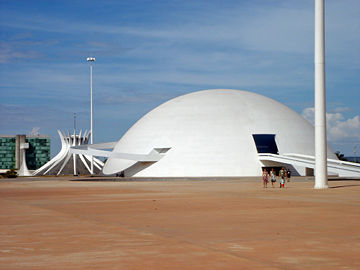
National Museum, Brasília, D.F. 2007
The Cultural Complex of the Republic («Complexo Cultural da República» in Portuguese) is a cultural center located along the Monumental Axis in Brasília. It consists of the National Library of Brasília and the National Museum of the Republic.
The National Library of Brasília (Biblioteca Nacional de Brasília in Portuguese) occupies an area of 16,744 square yards, consisting of reading and study rooms, an auditorium and a collection of over 300,000 items.
The National Museum of the Republic (Museu Nacional da República in Portuguese) consists of a 17,341 square-yard exhibit area, two 780-seat auditoriums and a laboratory. The space is mainly used to display temporary art exhibits.
Paranoá Lake
Paranoá Lake is a giant artificial lake built in order to increase the amount of water available to the region. It holds the second largest marina in Brazil and is home to the capital’s wakeboard and windsurf practitioners.
Juscelino Kubitschek bridge
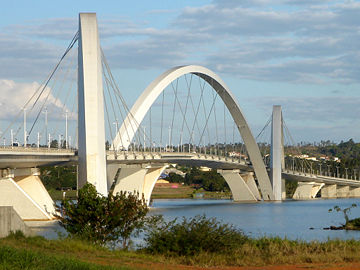
Bridge Juscelino Kubitschek (Ponte JK), over Lake Paranoa, Brasília, D.F. 2006
The Juscelino Kubitschek bridge, also known as the «President JK Bridge» or the «JK Bridge,» crosses Lake Paranoá. It is named for Juscelino Kubitschek de Oliveira, the former president of Brazil. It was designed by architect Alexandre Chan and structural engineer Mário Vila Verde.
The bridge consists of three, 200-foot-tall asymmetrical steel arches that crisscross diagonally. It is three-quarters of a mile long and was completed in 2002 at a cost of $56.8 million. It has a pedestrian walkway and is accessible to bicyclists and skaters.
Cathedral of Brasília
The Cathedral of Brasília is an aesthetic expression of the architect Oscar Niemeyer. On May 31, 1970, the glass-roofed cathedral was finished with only the 230-foot diameter of the circular area visible. This concrete-framed structure is a result of 16 identical assembled concrete columns, having hyperbolic sections and weighing 90 tons, representing two hands moving upwards to heaven.
Cultural events
Traditional parties take place throughout the year. In June, there are large festivals celebrating Catholic saints, such as Saint Anthony and Saint Peter. Throughout the year there are local, national, and international events spread through the city. Christmas is widely celebrated and New Year’s Eve usually hosts major events.
The Brasília Cultural Foundation sponsors many national meetings in the arts and letters, and several foreign information centers are available. The National Theater features dramatic, symphonic, and operatic works. Historical institutions include the Museum of Brasília, with a historical record of Brasília’s creation; the Federal Reserve Museum; and the Image and Sound Museum of the Institute of History and Geography.
Brasília is home to two major soccer teams: Brasiliense Futebol Clube and Sociedade Esportiva do Gama. The main football stadiums are the Estádio Mané Garrincha and the Serejão.
Brazilian achievements
A high-school student from Pará created a brick made of açai seeds
If you have ever had açai, chances are you probably had açai from Pará.
That’s because 90% of all açai comes from Pará, but only 4% of this Brazilian fruit is used. The rest is waste.
And so much waste was causing an environmental issue in the region.
However, the high school student Francielly Rodrigues Barbosa, 18 years old, developed bricks from açai seeds.
With her project, Francielly helped not only the environment but also the local community. That’s because she created a low-cost alternative for people whose house walls were in bad condition.
Brazilian agronomist, Johanna Dobereiner identified specific types of bacterias that helped the nutrition of non-leguminous crop plants through nitrogen fixation in the roots.
Her achievements allowed for less environmental impact and the cheaper production of soybean. Nowadays, Brazil is one of the biggest exporters of soy.

Go, girls!
A Brazilian physician discovered Chagas disease
Carlos Chagas, a physician, born in Minas Gerais, discovered in 1909 the Chagas disease, which is named after him.
The disease is more common in rural areas of Latin America.
Here are some other exciting things about Brazil and Brazilians.
- In 1903, Vital Brazil discovered the polyvalent anti-ophitic serum, which is used to treat bites from poisonous snakes.
- In 1932, José Braz Araripe developed the automatic transmission in cars using hydraulic fluid.
- In 1936, Manuel Dias Abreu invented the rapid radiography of the lungs for screening tuberculosis.
- In 1945, brigadeiro.
- In 1959, Therezinha Beatriz Alves invented the rice colander after clogging her sink multiple times.
- In 1972, Andreas Pavel invented the walkman. At the time, it was called a stereo belt.
- In 1978, Marcos dos Mares Guias discovered that genetically engineered, synthetic “human” insulin could be produced using E. coli bacteria.
- In 1996, Carlos Eduardo Lamboglia invented the electronic panel used in soccer games to indicate assisted substitutions.
- In 2000, Aron de Andrade invented an artificial heart which is connected to the natural heart and powered by an electric motor. This is the world’s cheapest artificial heart model, and the only one that doesn’t require the extraction of the organ. It weighs only 700g.
- In 2004, Eduardo Saverin co-founded .
- In 2010, Michael Krieger co-founded Instagram.
Полезная информация для туристов
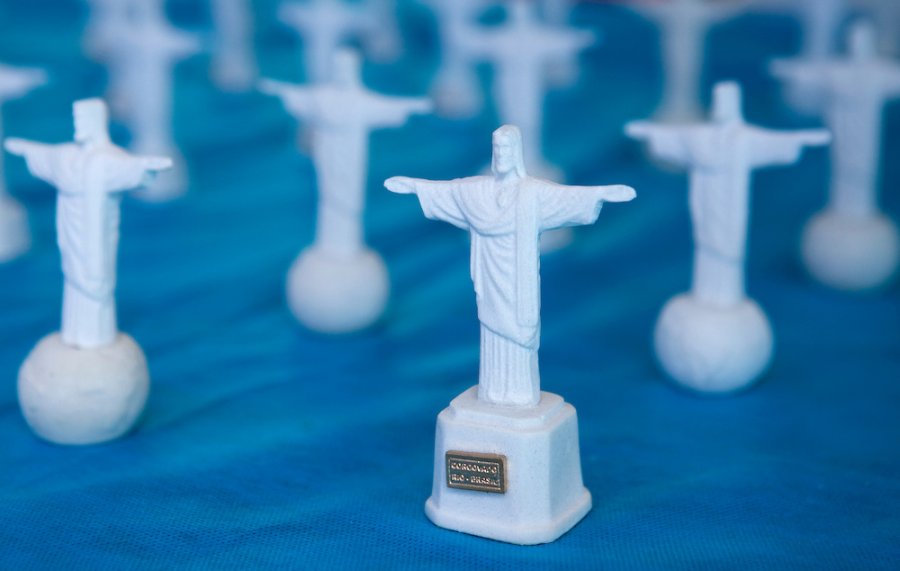
Традиционные покупки — интересные и занимательные сувениры: индейские сосуды, негритянские амулеты или изделия из красного дерева пау-бразил. Лучшее место для покупки сувениров — ярмарка «Хиппи», проходящая в воскресенье. Рио имеет также крупные торговые центры — Рио Сул и Барра Шоппинг. Серьезные покупки, которые стоит делать в Бразилии, — натуральные драгоценные камни: бриллианты, изумруды, топазы.
Бразилия входит в десятку наиболее криминальных стран мира. Не рекомендуется носить дорогостоящих ювелирных украшений, крупные суммы денег, оставлять на пляже без присмотра одежду, фотоаппараты и кошельки, принимать приглашения от малознакомых людей. Не посещайте районы факел (трущоб) даже в дневное время. Никогда не оставляйте документы, деньги и ювелирные украшения в номере отеля (отели не несут ответственность за пропажу вещей из номера). В курортных предместьях Рио, в Манаусе, у водопадов Игуасу безопасно.
Чаевые в дорогих ресторанах и барах составляют 10 % от счета (если в него не входит плата за обслуживание); в дешевых закусочных — 1—2 реала; в кафе на пляже не приняты; носильщику в отеле или аэропорту дают 1 реал; таксисту округляют счет в большую сторону.
Fun facts about Brazil laws
The flag should always be up-to-date
As said before, the starry night on the Brazilian flag depicts the night on November 15, 1889, the Proclamation of the Republic, and these stars aren’t random.
Each one of them represents a Brazilian state as well as the country’s capital in a specific constellation.
And another Brazil fun fact is that the law imposes the flag should always be up-to-date. That means if a Brazilian state is created or abolished, the stars on the flag should reflect that.
No one can get arrested on the days before an election
Well, almost no one. But this rather absurd Brazilian law that imposes authorities may not arrest or detain any voter starting five days before elections up to 48 hours after the election closing.
The only exceptions to that, so the only cases when a voter can get arrested is when the person is caught in committing a crime or if the person committed one of the following crimes instead:
- Torture
- Drug dealing
- Racism
- Heinous crimes
- Any offense against the state
It’s bizarre, I know. But the reason for this law is that the government wants to avoid unfair arrests caused by opposing parties that might try to frame other people and influence the election results.
Committing an environmental crime on Sundays and holidays is an aggravating factor
It’s common and right to punish crimes against the environment. But the weird fact about Brazil is that committing this kind of crime on Sundays, holidays, or during the night is an aggravating factor.
That’s because inspectors don’t work during those hours and days, and the government wants to discourage people from committing crimes during the period the inspectors don’t work, increasing the chance of getting infractors.
Краткая история
Федеративная Республика Бразилия, история которой началась в начале XVI столетии, – это страна, которая многое испытала на своем веку. В 1500 году мореплаватель Кабрал из Португалии открывает европейцам новые земли, на которых обитали индейские племена, а через 30 лет начинается колонизация страны. Сюда прибывают первые переселенцы и основывают ряд феодальных владений (капитании). Вскоре на тростниковых плантациях колонистов появляются рабы из Африки.
В XIX веке принц Жуан из Португалии, спасавшийся от войск Наполеона, провозглашает государство королевством. Через несколько лет его сын, объявивший Бразилию независимой, получает титул императора и отменяет рабство в стране. После свержения его власти, с 1889 года и по настоящее время Бразилия является федеративной республикой. Бывшие провинции, называемые штатами, получили автономию и собственные законодательные органы.
До середины 80-х годов прошлого века года страна находилась под властью авторитарных президентов, и только 30 лет назад начался период демократизации. Принципы государственного устройства действуют и поныне, а в конституцию вносятся новые поправки.
Facts about slavery in Brazil
Brazil was the country that imported the most African slaves
This disheartening fact about Brazil is still ignored by many people, while many others simply don’t know about it – the country imported by far the most slaves.
It’s estimated that about 12.5 million slaves were sent abroad, and 38.9% of all of them went to Brazil.
That’s somewhere around 4.8 million. Much more than the 2nd place British Caribbean which received about 2.3 million slaves.
Brazil was the last nation in the Americas to abolish slavery
As if having the most significant number of slaves wasn’t enough, Brazil was the last country in the Americas to abolish slavery in 1888.
After all the other countries in the western world and under significant pressure from Europe, Brazil finally abolished such horrific acts in the 19th-century.
Although this was a step toward equal rights for all races, it’s worth mentioning racism didn’t disappear from the country.

Facts about Brazil: 9% of the population is African descendant
Racism and slavery are touchy topics for the upper class in the country
Roughly 9% of the Brazilian population has African ancestry, and 46% is considered interracial, including Indigenous Brazilian, African, and European. We have ethnic groups from many regions worldwide, and we proudly say we’re a multicultural society.
See the slogan of this website, for example—experience diversity.
However, the economic inequality of blacks and mixed-race people in Brazil is alarming.
Many people claim the country is meritocratic and that racism doesn’t exist here; after all, Brazil is so multicultural, how could it be?
The reality isn’t pretty different, unfortunately. And many people, especially the upper classes of our society, simply deny talking about it.
However, more and more folks of all ethnicities feel suppressed by this. As a result, they are bringing up this and other touchy topics in the country, such as misogyny and the macho culture.
Editor’s note: The slogan of this website is “Experience Diversity” because my country is diverse, and I’m not only proud of it but I’m also fighting, together with fellow Brazilians, to make it equal for everybody.
World Heritage site
The Brazilian capital is the only city in the world built in the twentieth century to be awarded by UNESCO, a United Nations agency since 1987, the status of being a World Heritage Site.
In order to be considered for World Heritage status, a site must fulfill one of ten standards for qualification. Brasilia fulfilled two:
- to represent a masterpiece of human creative genius
- to be an outstanding example of a type of building, architectural or technological ensemble or landscape which illustrates (a) significant stage(s) in human history
Created from nothing in the center of the country Brasilia is a landmark in the history of town planning, from the layout of the residential and administrative districts to the symmetry of the buildings themselves, which are designed to harmonize with the city’s overall design. The official buildings, in particular, are innovative and imaginative.
Credits
New World Encyclopedia writers and editors rewrote and completed the Wikipedia article
in accordance with New World Encyclopedia standards. This article abides by terms of the Creative Commons CC-by-sa 3.0 License (CC-by-sa), which may be used and disseminated with proper attribution. Credit is due under the terms of this license that can reference both the New World Encyclopedia contributors and the selfless volunteer contributors of the Wikimedia Foundation. To cite this article click here for a list of acceptable citing formats.The history of earlier contributions by wikipedians is accessible to researchers here:
Brazil history
The history of this article since it was imported to New World Encyclopedia:
History of «Brazil»
Note: Some restrictions may apply to use of individual images which are separately licensed.
Климат
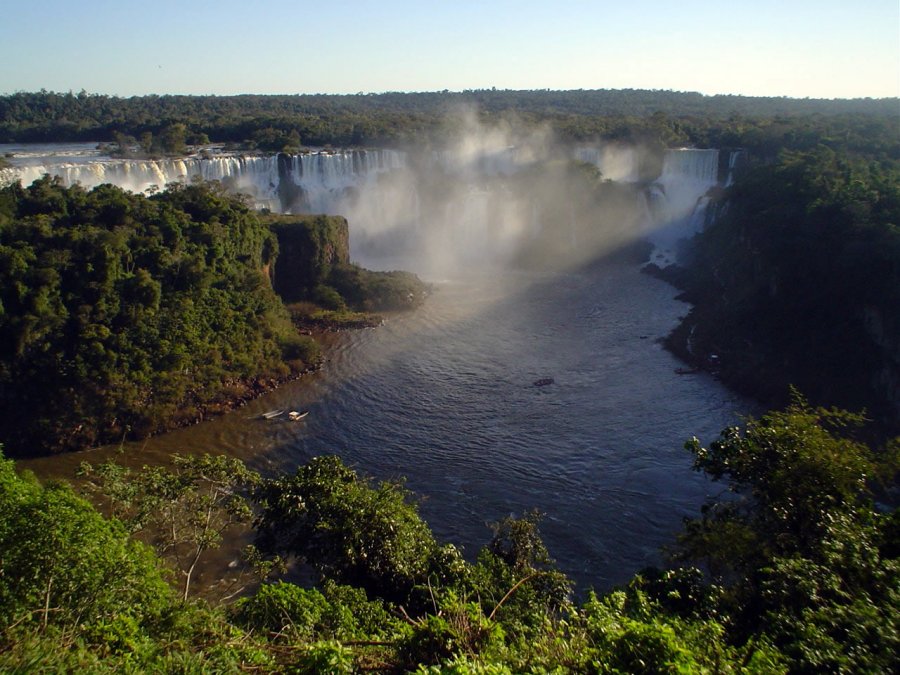
Несмотря на то, что 90% территории страны находятся в тропическом поясе, более 60% населения Бразилии проживает в зоне умеренных температур, формирующихся под воздействием преобладющих высот, дующих со стороны моря ветров и фронтов холодного воздуха.
В Бразилии представлены пять климатических типов: экваториальный, тропический, полузасушливый, тропический высокогорный, и субтропический. Для городов, расположенных на равнинной местности, таких как Сан-Пауло, Бразилиа и Бело-Оризонте, характерны умеренные температуры среднее значение которых составляет + 19 градусов.
#BANNER#
Города Рио-де-Жанейро, Ресифи и Салвадор, расположенные на побережье, характеризуются жарким климатом, который смягчает тропический ветер.
Субтропический климат южных городов, таких как Порто-Алегре и Куритиба, сравним с некоторыми регионами США и Европы, где случаются периодические заморозки. Зимой в этом поясе температура может опускаться ниже нуля.
Несмотря на расхожее мнение о том, что в бассейне Амазонки царит невыносимая жара, температура в этом районе не превышает + 32 градусов, а ее среднегодовое значение составляет + 22-26 градусов при незначительных сезонных колебаниях в самые жаркие и самые холодные месяцы года.
Самый жаркий район Бразилии — это северо-восток. В период засухи, длящийся с мая по ноябрь, температура воздуха на северо-востоке повышается до + 38 градусов. По сравнению с Амазонкой этот район Бразилии характеризуется более резкими сезонными колебаниями температур. Вдоль побережья Атлантического океана от Ресифи до Рио-де-Жанейро средняя температура колеблется от + 23 до + 27 градусов.
На возвышенных территориях в глубине страны температура понижается до + 18-23 градусов. К югу от Рио-де-Жанейро различия между временами года становятся более отчетливыми, а сезонные колебания температур — более ярко выраженными. В этом районе страны среднегодовое значение температур составляет от + 17 до + 19 градусов.
Времена года в Бразилии распределяются следующим образом:
Весна: с 22 сентября по 21 декабря
Лето: с 22 декабря по 21 марта
Осень: с 22 марта по 21 июня
Зима: с 22 июня по 21 сентября
Brazil is massive
Brazil is the fifth most significant and most populated country in the world. In relative terms, Europe is slightly larger than Brazil, making it the largest country in South America.
Brazil is not only enormous, but it also boasts about two-thirds of the Amazon Rainforest. Although this is a fact about Brazil to be proud of, the government is doing little to nothing to preserve it.
Amazon, on the other hand, is the largest rainforest, and the place still has the world’s largest river in volume.
While Amazon is a unique place on earth, the world’s largest swamp is also in Brazil. The Pantanal is an “up and coming” tourist destination in the last five years.

